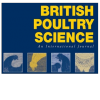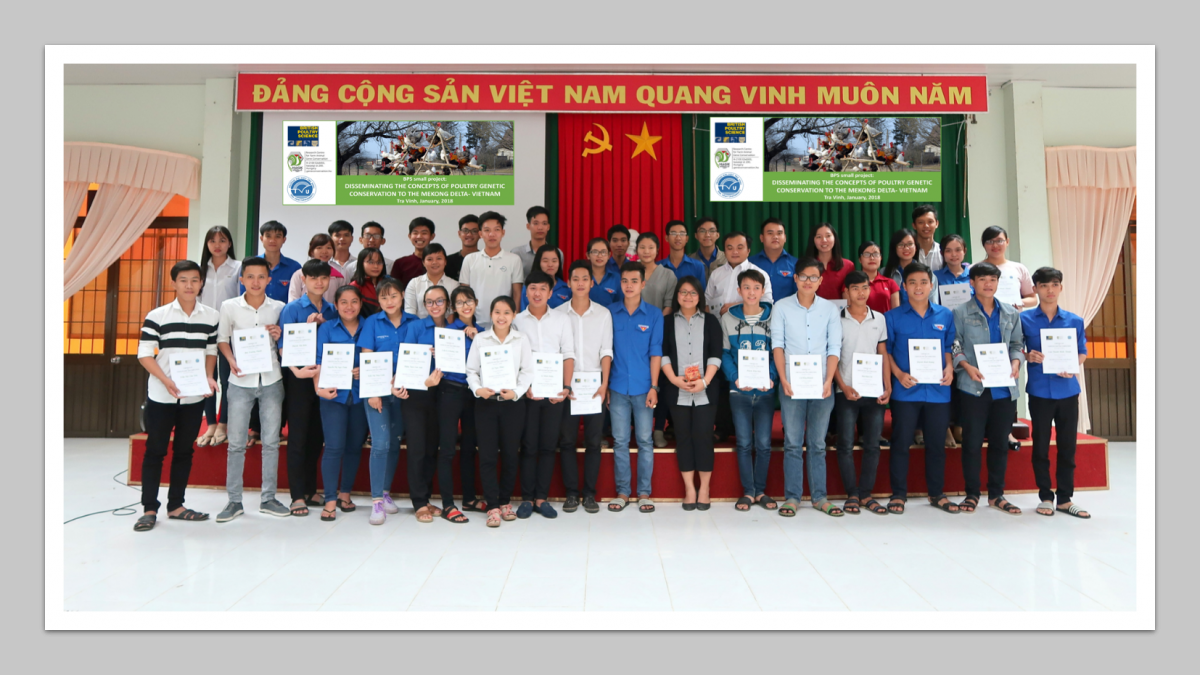
Junior researcher of HáGK Dr. Thieu Ngoc Lan Phuong organised a special training course on poultry gene conservation at Tra Vinh University, Mekong Delta, Vietnam in January in 2018. The project was fully financed by British Poultry Science Ltd., Great Britain.
Data obtained from the State of the World’s Animal Genetic Resources and Domestic Animal Diversity Information System global databank shows that indigenous or local breeds make up most of the world’s poultry genetic diversity. Despite their roles for food security, rural livelihoods and gender equity, most governments of developing countries regard them as general low important attribute in poultry industry. Therefore, disseminating the basic concepts of genetic conservation to developing countries, especially underprivileged regions, to improve the management of poultry genetic resources and foster conservation programme at regional level is essential. With attempt to focus on the need for the Mekong Delta region and to ensure that local ethnic people can actively be involved, Tra Vinh province, where approximately 30% of the population is Khmer, was chosen to conduct the project. In Tra Vinh particularly and Mekong Delta generally, number of high valuable local poultry breeds are believed to exit within Khmer community over centuries. Nonetheless, both adequate resource and funds for poultry conservation programme are lacking at present. Even at a higher education institution such as Tra Vinh University, the degree of knowledge related to poultry genetic conservation used for teaching is variable. The need for intellectual stimulation in poultry genetic conservation as well as raising public awareness of conserving indigenous poultry breeds in this region are certain.
The project started with a training course on poultry genetic conservation. The course took place at Tra Vinh University and attracted 50 students from Tra Vinh province and some other adjacent provinces. Within one week, it covered wide range of theoretical and practical knowledge related to poultry genetic conservation including:
- Basic concepts
- Methodology (in situ, ex situ, in vitro conserving methods, cryopreservation, application of genetic markers)
- Data of global, regional and local poultry genetic resources
- Poultry genetic conservation programme in Hungary and Vietnam
- Recent research and its results
A small survey conducted among veterinary students of Tra Vinh University during the course revealed that:
- 67.5% of the students believed that the conservation of Vietnamese poultry genetic resources is necessary
- 75% of the students believed that local poultry genetic resources should be protected
- 95% of the students believed that local poultry genetic resources have unique economic value
The course was followed by a workshop on “Challenges in Conservation Practice of Local Poultry Genetic Resources”. In the workshop, associate professor, Dr NGUYEN TRONG NGU, a lecturer from Can Tho University and Dr NGUYEN HUU TINH, vice director of the Institute of Animal Sciences for Southern Vietnam (IASVN) were invited to share their experiences in the field of poultry genetic conservation with the students. Furthermore, five groups of students presented their research works on Vietnamese local poultry breeds (10 students/group). After that, the students had opportunity to raise questions, discussed their concerns with and received advices from the two invited experts. They were mostly interested in:
- how to choose and set up the best systems for keeping local poultry breeds
- how to improve the economic value of local poultry breed
- how to communicate with small-scale poultry holders and encourage them to join the conservation programme of local poultry breeds
- how to minimise the inbreeding rate in conserved flocks when the number of breeding individuals are limited
- how to find, access and evaluate the valid data bank of poultry genetic resources and utilise these data for research
With support of local authority, a field trip to Long Duc village was also organised within the framework of the project. Long Duc village is about 15 km away from Tra Vinh city. There are approximately 100 families living in this village and each family keeps a flock of about 1000 birds (either broilers or layers). The birds are crossbreds of Binh Dinh and Noi chicken breeds. Both Binh Dinh and Noi chicken breeds are known as native Vietnamese chicken breeds. Binh Dinh originates from the middle region of Vietnam, while Noi is from the Mekong Delta. According to bird holders, these birds do not need much care. They can survive very well in both free range or semi-free range keeping systems. Day-to-day management of these flocks relies on family labour. The family members feed the chickens, clean the coops and apply veterinary treatments. They also grow vegetations in the surrounding of their household to add into birds’ diet. For examples, they grow Trichantera gigantea and use its leaves for feeding. Trichantera gigantea is a good crude protein source (leaves and thin stems) with good amino acid balance. Keeping these chickens requires low investment and generates additional income for their household. It also creates an at-home job for the elderly.
On average:
- A flock of 800-1000 birds needs 2 labours
- A density of the flock is about 4 birds/m2
- Broilers are 1.5-1.7 kg in 100-115 days, can be sold at the price of about 85000 VND/kg
- Layers are 1.3 kg in 3 months and be kept for 1.5 years with average egg production of 40-45%. At the peak of production, the egg production can reach 85%. Sex ratio is 1 male: 15 females. Egg can be sold for hatching at the price of 4500 VND/egg. Eggs are collected and stored in the farm for 3 days before selling.
The project received positive response from both staff and students of Tra Vinh University. It would lay down a milestone for establishing a regular training course on managing poultry for genetic resource at Tra Vinh University. Moreover, plans were also discussed to organise further workshops related to poultry genetic conservation every two years which involve both experts in the field and students, even local farmers or poultry holders who share the same interest; to initiate of a poultry genetic conservation programme in Tra Vinh province; to arrange staff and students exchange training programme between Tra Vinh University and HáGK; to further cooperate in poultry genetic research.
All participants of the training course greatly acknowledged the support of British Poultry Science Ltd.
